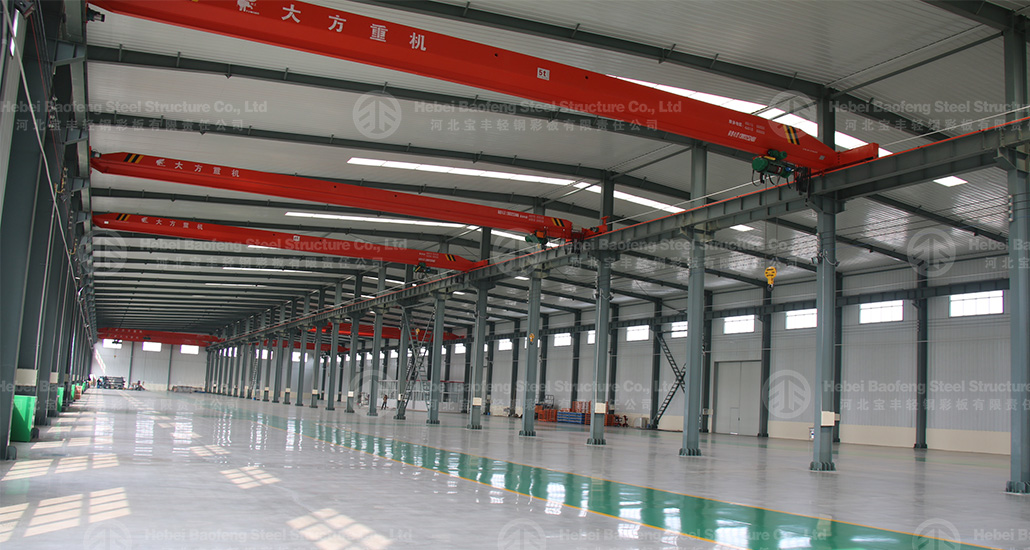
Precautions for installing overhead crane in steel structure workshop
Installing an overhead crane in a steel structure workshop requires careful planning and execution to ensure safety, stability, and long-term reliability. Below are the key precautions and best practices for a successful installation:
1. Structural & Foundation Precautions
A. Proper Foundation Design & Reinforcement
Check Load Capacity:
Ensure the workshop’s columns, beams, and foundation can support the crane’s static and dynamic loads (including hoisting, moving, and braking forces).
Use structural calculations (by a qualified engineer) to confirm the workshop’s ability to handle the crane’s weight and operational stresses.
Reinforce Weak Areas:
If the existing structure is insufficient, add additional steel supports, stiffeners, or bracing before crane installation.
Anchor Points for Runway Beams:
The runway beams must be securely anchored to the workshop’s columns or walls using high-strength bolts or welding (if permitted).
B. Runway Beam Installation
Alignment & Leveling:
Ensure runway beams are straight, level, and properly spaced to prevent uneven crane movement.
Use laser levels or surveying tools for precise alignment.
Deflection Check:
Runway beams should not deflect more than the manufacturer’s specified limit (usually L/800 to L/1000, where L = span length).
Welding & Bolting:
If welding is used, ensure full penetration welds and post-weld heat treatment (if required).
For bolted connections, use high-strength bolts (Grade 8 or higher) and proper torque specifications.
2. Crane Installation Precautions
A. Crane Assembly & Erection
Follow Manufacturer’s Guidelines:
Strictly adhere to the crane manufacturer’s installation manual for assembly, alignment, and testing.
Proper Lifting Techniques:
Use a mobile crane or auxiliary lifting equipment to assemble the crane, ensuring proper rigging and load distribution.
Avoid overloading temporary lifting equipment.
Wheel & Rail Alignment:
Ensure crane wheels are properly aligned with runway rails to prevent wheel chatter, derailment, or uneven wear.
Use laser alignment tools for precise positioning.
B. Electrical & Control Systems
Proper Wiring & Grounding:
Ensure all electrical connections are secure, insulated, and properly grounded to prevent shocks or short circuits.
Use explosion-proof wiring if working in hazardous environments (e.g., welding fumes).
Overload Protection & Safety Devices:
Install load limiters, anti-collision sensors, and emergency stop buttons for safety.
Ensure the control system is compatible with the crane’s power requirements.
C. Hoist & Rope Installation
Proper Rope Installation:
Install steel wire ropes correctly to avoid kinking, twisting, or improper spooling.
Ensure the rope is tensioned as per manufacturer specifications.
Hoist Alignment & Braking System:
The hoist must be vertically aligned with the runway to prevent side loads.
Test the braking system to ensure it stops the load smoothly without slipping.
3. Safety & Operational Precautions
A. Load Testing & Commissioning
Static Load Test (125% of Rated Capacity):
Lift a test load (125% of the crane’s rated capacity) to check for structural integrity and deflection.
Dynamic Load Test (110% of Rated Capacity):
Test the crane under moving and braking conditions to ensure stability.
Braking & Emergency Stop Tests:
Verify that the crane stops smoothly and safely under load.
B. Operator & Maintenance Training
Certified Crane Operators:
Only trained and certified operators should handle the crane.
Regular Maintenance Schedule:
Establish a preventive maintenance plan (daily, weekly, monthly checks) to prevent failures.
C. Anti-Collision & Safety Systems
Install Anti-Collision Sensors:
Prevent crane-to-crane or crane-to-structure collisions in multi-crane workshops.
Warning Lights & Alarms:
Use audible alarms and flashing lights for visibility and safety.
4. Environmental & Corrosion Protection
Protect Against Welding Fumes & Moisture:
Apply anti-corrosion coatings (paint, galvanization) on exposed steel parts.
Regularly clean the crane to remove dust and debris.
Weatherproofing (if outdoor):
If the workshop is open-sided, use weather-resistant materials and corrosion protection.
5. Legal & Compliance Checks
Permits & Inspections:
Obtain necessary building permits before installation.
Have the installation inspected by a certified structural engineer or crane inspector before operation.
OSHA/Local Regulations Compliance:
Ensure the crane meets OSHA (or local equivalent) safety standards for overhead cranes.
Conclusion
Installing an overhead crane in a steel structure workshop requires:
✅ Proper structural reinforcement
✅ Accurate alignment & leveling
✅ Safe lifting & assembly techniques
✅ Comprehensive electrical & safety systems
✅ Rigorous testing & operator training
Failure to follow these precautions can lead to:
⚠️ Structural failure (beam collapse, runway misalignment)
⚠️ Crane accidents (derailment, load drops)
⚠️ Increased maintenance costs (premature wear)

Thể loại
blog mới nhất